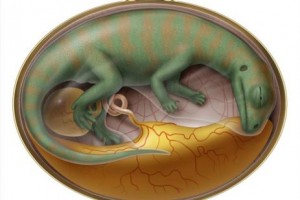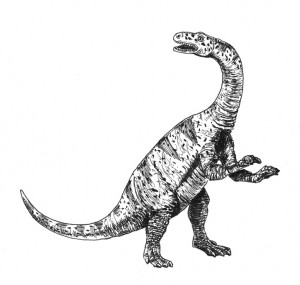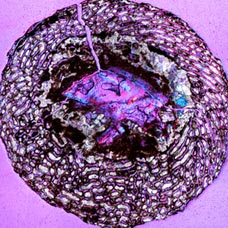Oldest Dinosaur Embryos Discovered in China
Dinosaur Nesting Site May Have Yielded Ancient Organic Material
A dinosaur nesting site that has been dated to the Early Jurassic is providing a team of international scientists with an unprecedented insight into the growth and development of baby dinosaurs. A scientific paper, published in the academic journal “Nature” and the cover story of this publication’s latest edition, also states that the research team may have discovered traces of organic remains. If this is the case and the fossils have not been contaminated by more recent organic material, then this discovery marks the earliest known organic remains of a terrestrial vertebrate.
New Research into Baby Dinosaurs
Picture credit: D Mazierski
The fossil site was discovered by Timothy Huang of the National Chung Hsing University (China) when he was exploring an area of Lower Jurassic aged strata in Yunnan Province (south-western China). His preliminary investigations led to the discovery of a monotaxic bone bed (an extensive amount of fossil material all assigned to the same species). The fossils consist of the remains of dinosaur embryos at various stages of development along with the remains of dinosaur egg shell. The strata represents a dinosaur nesting site.
Fossilised Dinosaur Embryos
Fossilised dinosaur embryos are extremely rare in the fossil record. The oldest known until the Chinese discovery, are believed to represent the Early Jurassic sauropodomorph of the genus Massospondylus, these fossils were discovered in South Africa, back in 1976. The South African fossil material was kept in storage for many decades and detailed research into these embryos and their ontogeny (growth rates) was published in 2010.
To read the Massospondylus article: Cracking the Mysteries of the Dinosaur Egg.
The Chinese embryos represent another type of sauropodomorph. The joint Canadian/Chinese scientific team have assigned these beautifully preserved fossil remains to the genus Lufengosaurus. This Early Jurassic dinosaur, closely related to the European Plateosaurus of the earlier Triassic Period, is known from more than twenty fossils of individuals. All these fossils have been found in the same geological formation as the newly discovered nesting site (Lufeng Formation). Lufengosaurus, was a herbivorous dinosaur which may have reached lengths in excess of eight metres. It was probably one of the largest dinosaurs living in this part of the world in the Early Jurassic (190-197 million years ago).
An Illustration of an Adult Lufengosaurus
Picture credit: Everything Dinosaur
Studying Two Hundred Embryonic Fossil Bones
The initial investigation of the bone bed by Timothy, yielded more than two hundred embryonic fossil bones. Realising the significance of his discovery he invited Dr Robert Reisz who had worked on the South African embryo fossils to investigate. Dr Reisz and his team (University of Toronto), working with Chinese colleagues quickly identified that the fossils did not represent a single nest but a number of broods of young, with many at different stages of embryonic development. This has permitted the team to study the growth and development of a single dinosaur species in great detail.
By comparing the femurs (thigh bones) of baby dinosaurs of different ages the team were able to suggest that these dinosaurs maintained a consistent and rapid rate of growth and development. For example, the thigh bones of these dinosaurs more than doubled in size whilst still in the egg. The team’s findings also indicate that sauropodomorphs had very short incubation times – the embryos grew quickly and hatched fast.
A Stained Cross Section of Embryonic Thigh Bone with Large Pore Spaces Indicating Rapid Growth
Picture credit: A. Leblanc
Archosaur Hatching Data
Chickens hatch in about three weeks, whereas crocodile eggs hatch after approximately one hundred days. The largest living lizard today, the Komodo dragon (Varanus komodoensis) has a much longer incubation period – over eight months. In addition, tiny muscle scars on the miniature bones indicate that the muscles of these herbivorous dinosaurs were well developed. This suggests that just like modern birds, baby dinosaurs moved around a lot inside their eggs. Highly active muscles before hatching suggests that these dinosaurs were far from helpless when they hatched.
It is not known whether these Sauropodomorphs had a precocial habit, the babies being virtually independent from their parents at birth and able to fend for themselves. Well developed muscles would have helped these young dinosaurs to escape from the nest, to avoid many potential predators and to start to find their own food.
The presence of such large numbers of fossil bones, free from the eggs in which they were formerly contained gave the researchers the opportunity to assess the growth rates of this type of dinosaur from a clade known for its gigantism. However, the scientists also detected traces of organic remains in the fossil material, astonishing to think that such matter could have possibly survived for 190 million years or so.
Studying Arctic Camels
Back in March, we reported on a joint Canadian and British research project which examined the fossilised remains of prehistoric camels in the High Arctic, although the bone found was extremely fragmentary and represented a tibia (lower leg bone), the research team discovered evidence of collagen present in the fossil. By extracting a portion of the preserved organic material, scientists from Manchester University were able to prepare a “collagen fingerprint” and when this data was compared to the collagen from extant mammals it was found that the fossil specimen most closely matched the collagen found in camels. This test helped to confirm that the 3.5 million year old tibia bone was from a prehistoric camel that once roamed high latitudes.
To read about the camel research: Camels of the Arctic.
Dr Reisz and his co-workers claim to have discovered locked deep inside the fossilised bones, evidence of collagen fibres, the main protein constituent of bone. Organic material usually decomposes very quickly and to find potential evidence of organic material in Early Jurassic vertebrate remains is simply “astonishing” according to some commentators.
The research team hope that they may be able to collect some of this organic material.
He stated:
“We are opening a new window into the lives of dinosaurs. This is the first time we’ve been able to track the growth of embryonic dinosaurs as they have developed. The bones of ancient animals are transformed to rock during the fossilisation process, so to find remnants of proteins in the embryos is really remarkable. If we can extract the collagen, then we can compare it to collagen in living organisms for further studies. Comparisons can be very valuable in evolutionary studies.”
The potential discovery of such ancient organic material in tiny, delicate fossilised bones of embryos, especially when one considers the porosity of bone material has been described by Dr. Reisz as “mind boggling”.
A “Collagen Fingerprint”
The team hope that if they are able to extract a sample, other researchers such as the University of Manchester research team who analysed the collagen sample from the prehistoric camel, might be able to create a “collagen fingerprint”. This would allow the prehistoric protein to be compared to the collagen of living vertebrates, perhaps once and for all cementing a link between the Dinosauria and Aves (birds).
The implications for this discovery may indeed be far reaching. If the remnants of collagen can be found in such an unusual fossil sample, then it might be more common in the fossil record than previously thought. If small bones could have preserved 190 million year old organic material then much more collagen could be lurking inside other fossil specimens. This could revolutionise our understanding of the taxonomy of extinct species.
As Dr Reisz commented:
“I suspect that if we start using this methodology elsewhere, we will find it [collagen] more frequently than we think.”
To view models and replicas of prehistoric animals: Prehistoric Animals and Dinosaur Models.




